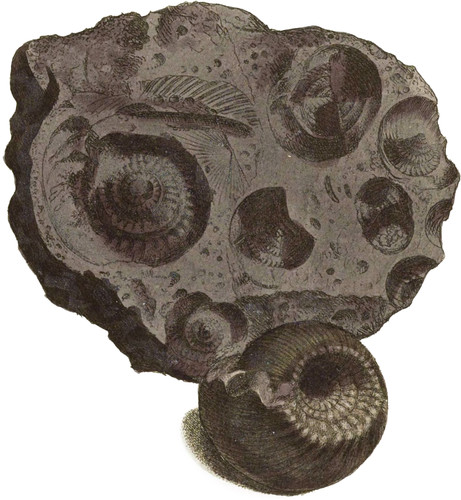 Enlarge
Enlarge
British Mineralogy
Iron Pyrites
- Div. 2. Imitative.
My friend Mr. Jonathan Salt first sent me Pyrites in this form tenor twelve years ago, and in a short time it decomposed and fell to pieces. I have since preserved several specimens in water. Mr. Farey observes to me that he has seen casts similar to these found in Whitley wood mine; near Sheffield, which mine is situated in the third coal strata, (See Farey’s Derbyshire, p. 214.) He has also presented me with specimens in lumps of Pyrites, called Brasses by the miners, found in a layer immediately above the lowest seam of Coal in his third Coal shale, having a variety of Sandstone called Crowstone, for its floor, in a mine South of Alton in Ashover. It is somewhat remarkable that these Pyrites should generally have lost the shell which has left so curious a cast, nearly like that of an hour-glass, being two cones, point against point, showing that the shell w r as perforated, or nearly so, at the first volution. It is not less remarkable, that it is the opinion of many that the shell itself is never to be found; and Mr. Martin does not seem to have known it, although he has figured it in Limestone, in his Petrificata Derbiensia, plate 33, fig. 3., under the name Ammonites Listen. The fragments brought me by Mr, Farey have a coaly outside, and also contain parts of Ammonites resupinatus of Martin, tab. 49. This Pyrites being very likely by exposure, to pass into Sulphate of Iron, or Green Vitriol, has given it value and great quantities are sold for making vitriol.
Since writing the above, I have been favoured by the Rev. H. Steinhauer, with some dark gray Limestone, in which shells of the same species are extremely abundant; some with a pyritaceous coatings and from an inch or more in diameter, down to the smallest speck, as if they had been a viviparous animal; the divisions I could not see, perhaps they were eradicated in the great catastrophe, I have, however, one bit that shows the undulations of one division, partly as seen in the lower figure. Mr, Steinhauer also favoured me with the following account.
“These fossils are found together with the Anomia Pecten, Gmel. 3342, in bails or nuclei of Limestone, which occur in a stratum of Coal schist us or shale, immediately above the coal. This stratum I have observed at a place about two or two miles and a half north of Halifax, on the road to Bradford, where the Limestone balls are sufficiently abundant to repay the trouble of erecting a kiln to burn them*. It extends northwards beyond Bradford to Idle, in the neighbourhood of Galverly and Farsley near Horseforth; but the Limestone seems less plentiful there; and is only used to mend the roads. The shale, however, is still full of impressions of these shells, and frequently contains crystals of Selenite, particularly at Idle. The Limestone nodules are often much mixed with Pyrites, which sometimes seems to indicate petrified wood, but none of the usual fossils of the neighbourhood, such as Pliytolithus verrucosus, sulciculmis, &c.
- * They were known abeady to Richardson, as appears from one of his letters preserved by Llhwyd.

